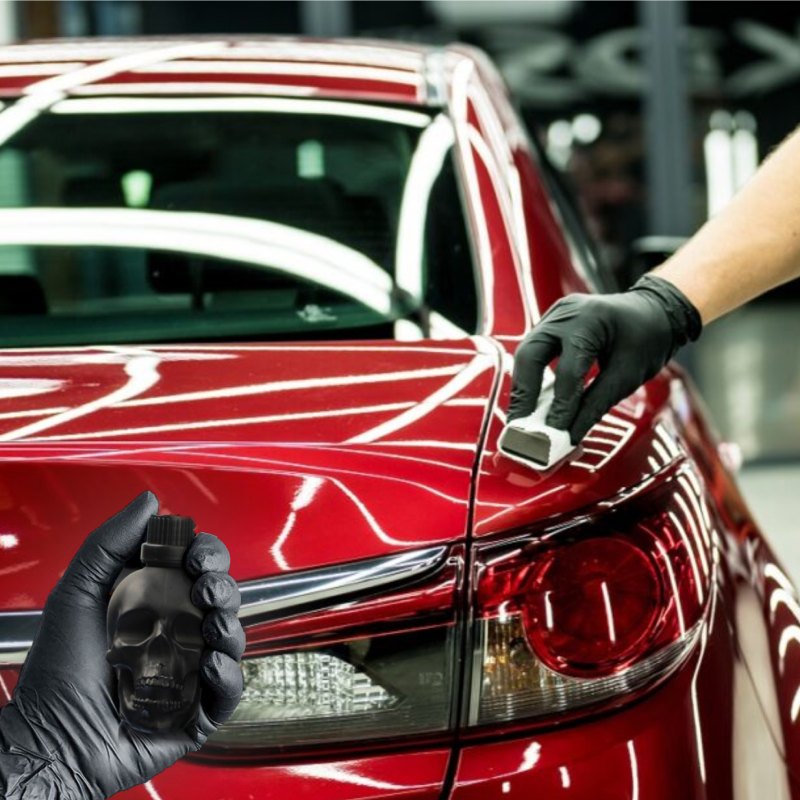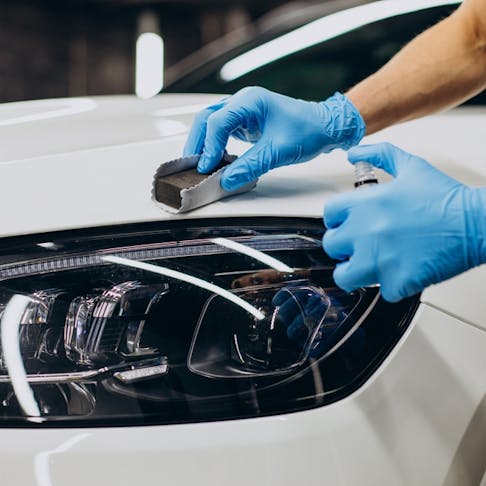Ways Ceramic Coating Newark saves you money over time
Wiki Article
Checking out the Scientific Research Behind Car Ceramic Coating and Its Safety Properties
The scientific research of car ceramic coating presents a fascinating research study in sophisticated automobile protection. Made up mostly of silicon dioxide and polymers, these finishes form a robust bond with car paint. This interaction enhances longevity versus environmental threats while offering hydrophobic advantages. Nonetheless, the intricacies of just how these finishings work and their long-lasting benefits continue to be less understood. Unloading these information discloses why ceramic coatings are coming to be a preferred selection for lorry treatmentWhat Is Ceramic Coating?
Ceramic coating is a fluid polymer that chemically bonds to the surface area of a car's paint. This innovative safety layer enhances toughness and uses remarkable resistance to environmental variables. Unlike standard wax or sealants, which supply short-lived defense, ceramic finishes develop a durable guard that can withstand harsh conditions such as UV rays, acidic pollutants, and severe weather condition. When applied correctly, the coating develops a hydrophobic surface area, creating water to grain and slide off, which aids in keeping the vehicle's tidiness. Additionally, it supplies improved gloss and deepness to the paint, making the vehicle show up more sleek and vivid. The application procedure typically entails thorough surface area prep work, including cleaning and polishing, to guarantee peak bonding. Therefore, ceramic coverings are ending up being progressively prominent amongst car fanatics and those looking for to protect their financial investments, guaranteeing to maintain the car's aesthetic allure while reducing the regularity of maintenance.The Structure of Ceramic Coatings
The detailed formulation of ceramic finishes largely is composed of silicon dioxide (SiO2), which is derived from all-natural sources like quartz and sand. This vital component supplies the structure for the coating's sturdiness and protective top qualities. In enhancement to SiO2, ceramic finishings commonly include numerous polymers and ingredients that enhance adhesion, versatility, and resistance to ecological aspects. These substances function synergistically to develop a robust obstacle against pollutants such as dirt, chemicals, and UV rays.Furthermore, some formulas include titanium dioxide (TiO2) or other nanomaterials, which can enhance the coating's hydrophobic properties, causing improved water repellency. The precise structure can differ greatly amongst makers, impacting performance and longevity. Ultimately, the combination of these components culminates in a protective layer that not only enhances the visual appeal of lorries but also offers to lengthen their life-span by protecting the surface area from possible damage.Exactly How Ceramic Coatings Work
Recognizing exactly how ceramic finishes function entails discovering their chemical make-up, which contributes to their protective high qualities. The application procedure is vital for attaining ideal results, while durability and toughness elements identify the coating's performance over time. With each other, these components highlight the benefits and efficiency of ceramic finishes for car security.Chemical Structure Explained
While numerous car owners look for durable security for their automobiles, the chemical make-up of ceramic finishes plays an essential duty in their performance. These coatings mainly contain silicon dioxide (SiO2), which is originated from natural minerals. This compound forms a solid bond with the lorry's paint, producing a sturdy, safety layer. Furthermore, many ceramic layers consist of titanium dioxide (TiO2), improving their hydrophobic buildings and resistance to UV rays. The visibility of polysiloxanes can better improve adaptability and longevity. With each other, these elements add to the coating's ability to drive away water, dust, and contaminants, while likewise giving a high-gloss surface. Comprehending this chemical foundation assists car proprietors appreciate the robust security used by ceramic layers.Application Refine Introduction
Applying ceramic finishings entails a thorough process that guarantees perfect bonding and security for the lorry's surface area. Complete cleaning and decontamination of the car's exterior are done to eliminate dust, crud, and previous waxes. This step verifies that the surface area is without impurities that can prevent attachment. Following this, the paint is usually brightened to boost quality and get rid of any kind of blemishes. Once prepared, the ceramic coating is applied in tiny areas utilizing an applicator pad, enabling consistent protection. The coating is after that left to treat, forming a strong chemical bond with the surface. Appropriate curing times and conditions are critical, as they verify the coating attains its optimum effectiveness and protective qualities.Longevity and Sturdiness Factors
Ceramic finishes are created to give resilient defense with their advanced chemical make-up, which produces a durable obstacle versus environmental impurities. The longevity of these coatings is affected by variables such as the thickness of the application, the top quality of the item, and the problems under which the vehicle is revealed. High-grade ceramic finishes can last numerous years, resisting scratches, UV rays, and chemical stains. Proper maintenance, consisting of normal cleaning and periodic reapplication, can better improve longevity. Furthermore, ecological variables like climate and direct exposure to pollutants can influence the lifespan of the coating. Overall, when used and maintained correctly, ceramic layers use exceptional longevity, making them a popular option for car lovers looking for to maintain their vehicle's appearance.Hydrophobic Features and Water Repellency
Hydrophobic properties are a characteristic of quality car ceramic finishings, significantly improving the automobile's surface area performance. These finishes produce a molecular bond with the car's paint, causing a surface that repels water effectively. When water enters contact anonymous with a ceramic-coated surface area, it grains up and rolls off, minimizing the amount of liquid that remains on the paint. This behavior not only adds to a cosmetically pleasing appearance but likewise lowers the build-up of contaminants such as dust, gunk, and road salts.The improved water repellency causes less complicated cleansing and maintenance, as less effort is required to get rid of undesirable compounds. Additionally, the hydrophobic nature of ceramic finishings helps in preventing water places, which can mar the surface of uncoated surfaces. On the whole, the unification of hydrophobic properties in ceramic coverings plays an important role in maintaining the vehicle's excellent appearance while streamlining maintenance.Protection Against Scratches and UV Damages
Car ceramic coverings use substantial defense against scrapes and UV damage. The scratch resistance mechanism develops a resilient layer that absorbs influences, while the UV shielding advantages assist maintain the vehicle's paint stability over time. Together, these attributes add to a longer-lasting and aesthetically enticing coating.Scrape Resistance System
Utilizing sophisticated modern technology, ceramic finishes give a robust shield versus scratches and UV damage, boosting the longevity and look of lorry surfaces. The scratch resistance mechanism of these finishes is credited to their one-of-a-kind molecular structure, which develops a durable bond with the automobile's paint. This bond develops a hard, safety layer that can take in impacts and resist abrasions. In addition, the smooth surface area of the coating decreases rubbing, making it tough for impurities to stick and trigger scrapes. The chemical structure of ceramic coatings typically consists of nanoparticles that strengthen the protective layer, more improving its durability. As a result, cars treated with ceramic finishes exhibit significantly enhanced scratch resistance compared to typical wax or sealants, guaranteeing a beautiful coating gradually.UV Shielding Conveniences
The safety top qualities of ceramic coverings visit this site extend beyond scrape resistance to consist of significant UV shielding benefits. These finishings produce a robust barrier that shows hazardous ultraviolet rays, guarding the vehicle's paint and underlying materials. Long term exposure to UV radiation can cause fading, oxidation, and degeneration of the paint surface. By integrating ceramic coverings, vehicle proprietors can successfully alleviate these risks, preserving the aesthetic charm and integrity of their cars. In addition, the UV blocking buildings add to boosted longevity, decreasing the frequency of repainting and maintenance. Eventually, the integration of ceramic layers provides an extensive solution for shielding lorries from the destructive results of sunlight exposure, guaranteeing a continual, vivid look gradually.The Long life and Upkeep of Ceramic Coatings

Often Asked Questions
Can Porcelain Coating Be Applied to Any Kind of Automobile?
Ceramic coating can be related to different kinds of automobiles, consisting of autos, vehicles, and motorbikes. However, surface area prep work and compatibility with specific products are vital for ideal bond and effectiveness of the coating.Just How Much Does Ceramic Coating Normally Cost?
Ceramic coating generally costs in see this site between $500 and $2,000, depending upon elements such as automobile size, coating top quality, and specialist application. The financial investment can offer lasting protection and boost the lorry's look gradually.
Is Professional Application Required for Finest Results?
The need of professional application usually depends upon preferred results. Professionals commonly assure appropriate surface area prep work and application strategies, bring about excellent bonding and durability of the coating, which might be challenging for unskilled individuals to achieve.Can Porcelain Coatings Be Gotten Rid Of or Fixed?
Ceramic coverings can be gotten rid of or fixed, though the process may need certain solvents or strategies - Ceramic Coating Newark. Appropriate elimination is vital to avoid damage to the underlying surface area, highlighting the value of professional assistance for perfect outcomesExactly How Does Porcelain Coating Compare to Standard Wax?
The comparison between ceramic coating and typical wax reveals that ceramic finishings supply exceptional toughness, enhanced security against environmental contaminants, and longer-lasting sparkle, while wax calls for much more constant application and gives much less general resistance to damage.Report this wiki page